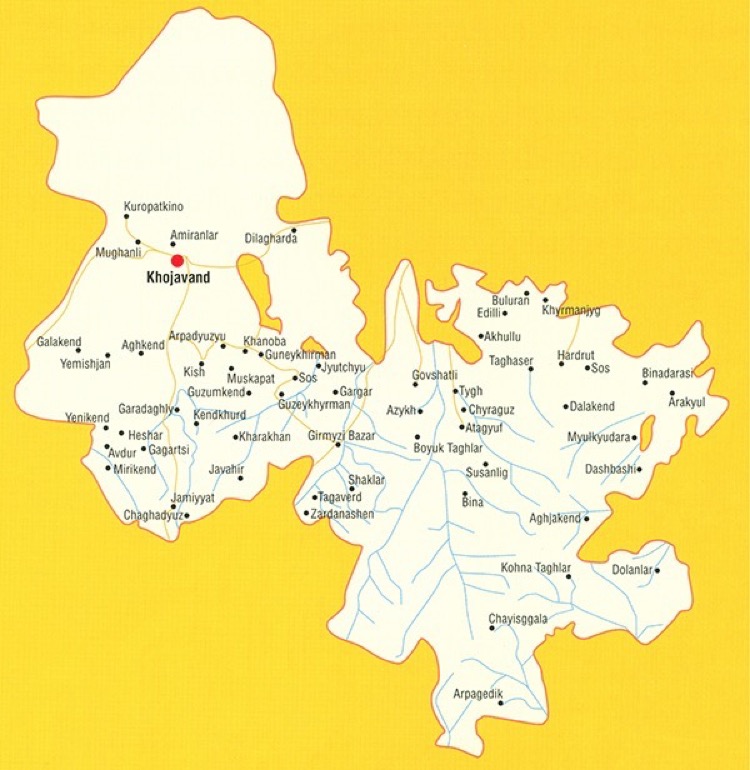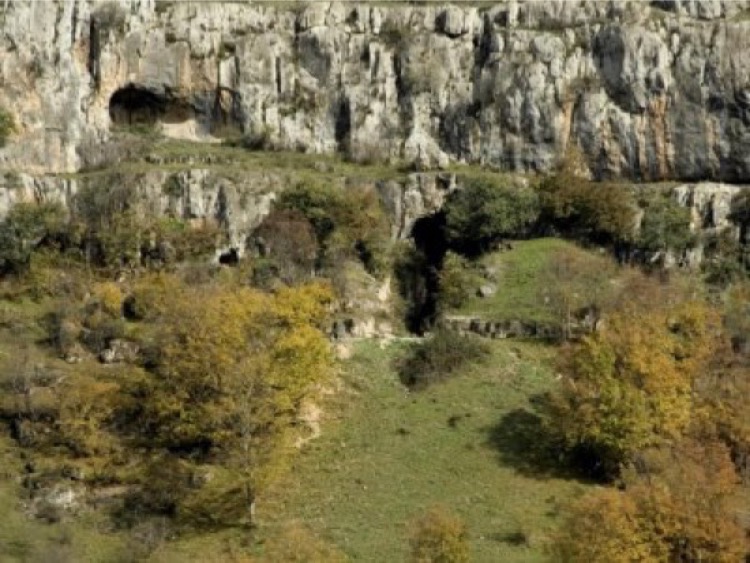Khojavand district - is the administrative district of the Republic of Azerbaijan. It is located in the south - eastern part of the Karabakh Chain of Minor Caucasus. Its area is 1460 km2; the population is 44,100 (01.01.2020). The central town is the city of Khojavand. The district's territory was occupied by the Armenian armed forces on October 2, 1992. The Azerbaijani army liberated Hadrut settlement and 35 villages of Khojavand district on September 27-November 9, 2020.
The district covers the followings: Khojavend city, Hadrut and Girmizi Bazar settlements and villages of Amiranlar; Heshan; Akhullu; Dolanlar; Bina; Garadagli; Boyuk Taghlar; Salaketin; Kuropatkino; Arpaduzu; Muganly; Jamiyyat; Agkend; Khanoba; Khojavend; Kish; Tagaser; Ghyrmyzyqaya; Adisha; Veng; Dagdoshu; Gachbayli; Sheher; Shyx Dursun; Mavas; Azykh; Zogalbulag, Aragul; Dashbashy; Mulkudere; Jilan; Bunyadly; Gavahin; Agbulag; Binederesi; Sor; Gargar; Zavadykh; Kharkhan; Bulutan; Khyrmanjyg; Malikjanly; Guneykhyrman; Guneychartar; Guzeykhyrman; Guzeychartar; Gagartsi; Garytepe; Qarakend; Shahyeri; Garakend; Yemishjan; Gunashli; Gushchular; Kendkhurd; Mushkapat; Guzumkend; Garazemi; Tug; Susanlyg; Aragut; Aghdam; Kohne Taghlar; Aghjakend; Mirikend; Avdur; Chaylaggala; Arpagedik; Petrosashen; Chyraguz; Mammaddere; Tsakuri; Yenikend; Chorakli; Edilli; Dudukchu; Agbulag; Sos; Jutju; Tagavard; Chagaduz; Zerdanashen and Khatai.
The following educational and social institutions ran its activities before the occupation: 20 secondary schools; 5 pre-school educational institutions; 20 clubs; 19 libraries; 4 hospitals; 7 other medical institutions.
Prior to the occupation, the district had many historical-archaeological and architectural monuments, including the ancient Azykh Cave (dates back to almost 1.2 million years B.C.), fortresses (1st-8th centuries), the Albanian Temple (10th century), the turbeh (13th century) and others.
Amaras Monastery Complex
The remnants of Amaras town, the episcopal centre of Caucasian Albania, are available in the village of Jutju located on the right bank of the same-named river. According to historical materials, the first Christian temple was erected in Amaras in the 4th century, and after one of the Albanian bishops’ burial this sanctuary became a place of pilgrimage. Nowadays, that grave remains in a shrine under the altar in a church of the complex. This shrine was revealed by Azerbaijani archaeologists in 1970. The Amaras monastery complex was built in the 9th century, but for the next centuries it had been repeatedly repaired and modified. The complex was remodelled to its current appearance in the 19th century.
The Amaras Monastery had a rectangular plan and round towers at its corners fortified the construction. Its patio is surrounded by the castle walls with cells, dwelling and household premises built into along their perimeter. The household part of the monastery is separated from a church court by a number of additional rooms. These rooms and premises imparting extra strength to the castle walls were built of rough stone and the archivolt – of good-hewn stones. The entrance to the monastery courtyard is at the western end of the south wall. Being the main construction of the complex, the church was raised in the middle of the court. The entrance to the church was built on the western side.
Azikh cave
Azikh is the largest karstic cave in Azerbaijan, located in Khojavand region, at a height of 900 m. There are 6 cells connected with each other. Azikh is one of those rare caves of the Palaeolithic period which started to be explored by the Azerbaijani researchers in 1960. In 1968, there was found a fragment of a lower jaw belonged to the ancient man lived 350 thousand years ago (Ashel period). This is the third found relic in the world. 10 cultural layers evidencing the ancient man’s long-term presence in Azikh cave were discovered during the excavations carried out there. Primitive people living there were engaged in collecting, hunting and fishing. There were revealed some fireplaces with a large amount of charcoal and ash remains. Azikh cave confirms that the territory of Azerbaijan was obviously human inhabited 1 million years ago.
At the present time Azikh cave is under the occupation of the Armenian Armed Forces. In that cave called presently “Azokh” by Armenians, the Archaeologists of the Armenian Academy of Sciences conduct "research", and try to prove that “the most ancient Armenian” lived there.
On November 9, 2020 Azikh village was liberated from occupation.
Taghlar Cave Camp
Taghlar cave camp is the most immense cave camp in the territory of Khojavand region relating to the Mousterian culture. The cave is very important in terms of remains of material culture, stratigraphy and long-term residence there. Taghlar cave camp is located on the left shore of the Guruchay River. Since 1963, the Paleolit archaeological expedition conducted archeological excavations in Taghlar Mousterian camp. As a result of excavations more than 7000 stone tools and more than 2000 animal bones were found there. 6 cultural layers were found out in sediments of Taghlar camp. Unlike all the other monuments existed in the entire Caucasus and the Near East, Taghlar was the only site that had a permanent settlement.
On November 9, 2020 Taghlar village was liberated from occupation.
Immovable historical and cultural monuments of state importance
ARCHITECTURAL MONUMENTS
Name of the monument |
Construction date |
Location |
Albanian temple |
1170 |
Hadrut settlement |
Albanian temple |
1147 |
Mammadzar village |
Albanian temple |
1197 |
Tugh village |
Girmizi temple |
1000 |
Tugh village |
Albanian temple |
1094 |
Zoghalbulag village |
Albanian temple |
900 |
Tugh village, Vang territory |
Albanian temple |
1131 |
Sakuri village |
Albanian temple |
IV-VI cc. |
Susanlik village |
Albanian temple |
4th-6th cc. |
Susanlik village |
Fortress |
|
Chaylaggala village |
Temple |
1635 |
Taghaser village |
Religious complex |
13th c. |
Sor village |
Fortress |
|
Sor village |
Temple |
1241 |
Boyuk Taghlar village |
Albanian temple |
1236 |
Guneychartar village |
Albanian temple |
995 |
Gavahin village |
Albanian temple |
4th c. |
Machgalashen village |
Albanian temple |
701 |
Chorakli village |
Albanian temple |
8th c. |
Chorakli village |
Albanian temple |
5th c. |
Chorakli village |
Church |
1270 |
Chorakli village |
Church |
12th c. |
Chorakli village |
Amaras monastery |
4th c. |
Jutchu village |
Temple |
12th c. |
Shikh Dursun village |
Albanian temple |
675 |
Taghaverd village |
Fortress |
3th c. |
Taghaverd village |
Temple of Baghir Khan |
12th c. |
Jamiyyat village |
ARCHAEOLOGICAL MONUMENTS
Name of the monument |
Construction date |
Location |
Nargiztapa settlement |
Early and Middle Bronze Age |
To the south from Khojavand city |
Necropolis |
Late Bronze and Early Iron Age |
Dolanlar village |
Immovable historical and cultural monuments of local importance
ARCHITECTURAL MONUMENTS
Name of the monument |
Construction date |
Location |
Temple |
14th c. |
Dolanlar village |
Temple |
|
Atagud village |
Mausoleum |
17th c. |
Khojavand settlement |
Church (temple) |
17th c. |
Taghavard village |
Temple |
18th c. |
Hadrut settlement |
Temple |
13th c. |
Tugh village |
Temple |
1747 |
Tugh village |
Bridge |
18th c. |
Near Tugh village |
Agh church |
17th c. |
Vang village |
Temple |
1664 |
Gargar village |
Temple |
17th c. |
Sakuri village |
Temple |
17th c. |
Sur village |
Fortress |
|
Chanakhchi village |
Temple |
|
Khsaberd village |
Temple |
|
Taghaser village |
Church |
17th c. |
Arakul village |
Temple |
18th c. |
Domi village |
Temple |
19th c. |
Shagah village |
Temple |
1896 |
Norashen village |
Temple |
|
Banazur village |
Temple |
19th c. |
Kemrakuch village |
Temple |
19th c. |
Gochbay village |
Temple |
|
Chiraguz village |
Temple |
|
Khirmanchig village |
Temple |
|
Anaku village |
Temple |
1698 |
Agjhakand village |
Temple |
18th c. |
Zamzur village |
Temple |
|
Malikjanli village |
Temple |
|
Bulutan village |
Temple |
|
Edilli village |
Temple |
|
Dudukchu village |
Temple |
|
Aghbulag village |
Temple |
|
Tak village |
Temple |
18th c. |
Azikh village |
Temple |
19th c. |
Bunyadli village |
Temple |
|
Dashbashi village |
Temple |
13th c. |
Dolanlar village |
Lower part of mausoleum |
12th-13th cc. |
Dolanlar village |
Albanbendi church |
17th c. |
Garakand village |
Mausoleum |
|
Khatek village |
GARDEN-PARKS, MONUMENTAL AND MEMORIAL MONUMENTS
Name of the monument |
Construction date |
Location |
Memorial monument to our citizens, who died during World War II |
|
Khojavand settlement |


